His was a world infused with color. Born to a painter and art professor as a father, Diego Jose Santiago Francisco de Paula Juan Nepomuceno Crispin Crispiniano de los Remedios Cipriano de la Santisima Trinidad Ruiz Blasco y Picasso Lopez, otherwise known as Picasso, was exposed to the wonderful world of art quite early in his life. His father trained the young protégé in the techniques of drawing and oil painting. And by the age of 13, Picasso surpassed even his own father’s talents.
Drawing from his life’s experiences; from the depression he went through with the death of his dear sister, Conchita, to the time when he and his friends stared poverty in the face as struggling, young artists, and to the times when he embraced love and passion in the arms of his wives and countless mistresses, Picasso was able to produce some of his most famous works.
1. Blue Nude (1902)
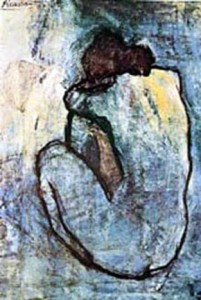
One of Picasso’s artworks from his Blue Period, the ‘Blue Nude’ was created at a time when Picasso was mourning over the suicide death of his good friend, Casamegas. This painting revealed Picasso for the sheer genius that he was, as he was able to effectively convey the different levels of sadness he was experiencing while using just the single color of blue. The ‘Blue Nude’ is one of the more popular and sought after among Picasso’s numerous masterpieces.
2. The Old Guitarist (1903)
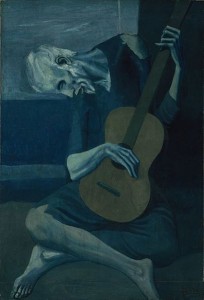
Another of Picasso’s works from his Blue Period, the disquiet in this painting clearly showed the painter to still be in mourning for his dead friend. Also, at the time, Picasso was just recovering from experiencing for himself a previous year of poverty. He remained very sympathetic to the less fortunate souls of society and would oftentimes depict them in his paintings.
Many art critics say the distortion of the body in this painting reminded them of the 16th century works of El Greco. Technical examinations also revealed two previous creations underneath ‘The Old Guitarist.’ This could explain why there seems to be a ghostly image of a woman just beside the man’s drooping head. ‘The Old Guitarist’ is now in the care of the Art Institute of Chicago,in the Helen Birch Bartlett Memorial Collection.
3. Les Demoiselles d’Avignon (1907)
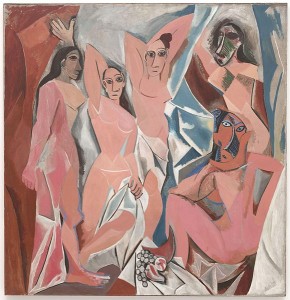
Originally titled ‘The Brothel of Avignon,’ this is a large oil painting depicting five nude female prostitutes from Barcelona. All five women appear distorted and angular to the point of being menacing and savage. Some believe that this painting also shows Picasso’s fear and loathing of the female anatomy, something which he at the same time idealized as he found women irresistible.
4. Three Musicians (1921)
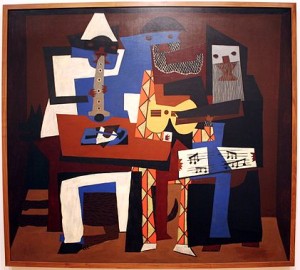
‘Three Musicians’ is actually two collage paintings of the same title done in oil using the Synthetic Cubism style Picasso was known for. The painting depicts the friendship between a harlequin, a Pierrot, and a monk which are believed to be representations of Picasso himself and his two good friends, poets Guillaume Apollinaire and Max Jacob. One version of the painting may be found at the Museum of Modern Art (MoMA) in New York City while the other is in the Philadelphia Museum of Art
5. Girl Before a Mirror (1932)

Painted during Picasso’s cubism period, ‘Girl Before a Mirror’ was said to have been modeled after Picasso’s then lover, Marie Therese Walter. In the painting, the bold, colorful patterns of the backdrop compete with what was supposed to be the main focal point of the artwork, that of the girl and her mirror image. Quite a controversial piece, some sectors claim the painting to be erotic in nature. On the other hand, some interpret the two sides of the girl’s face as the depiction of her worldliness and innocence. Still, some see a woman confronted with her insecurities as she stares at her imperfections in the mirror.
6. Le Rêve (The Dream) (1932)

‘Le Reve’ again features Picasso’s mistress Marie Therese Walter. Although it was created during his period of distorted depictions, the erotic nature of the painting was not missed by his critics. Some noted how Picasso showed an erect penis, purportedly his, in the upturned face of the woman.
7. Asleep (1932)
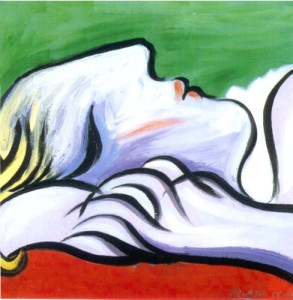
Marie Therese Walter is now depicted to be asleep, her calm and expressionless face resting in-between the solid block of colors green and red. Unlike that of his other paintings wherein the viewer gets an insight through the model’s expression, this painting shows the point of view of the artist. Thereby, the viewer gets a glimpse of Picasso’s deep love and admiration for his muse as he watches her sleep.
8. Nu au Plateau de Sculpteur (Nude, Green Leaves and Bust ”œ 1932)
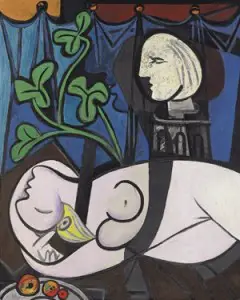
Still featuring Picasso’s muse Marie Therese Walter, not much has been written or said about this particular painting. However, this masterpiece was sold for a record price of $106.5 million at Christie’s in New York in May of 2010.
9. Guernica (1937)
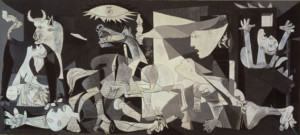
Picasso’s most famous masterpiece, ‘Guernica’ is a very powerful political statement against the Nazi’s bombing of the Basque town. It clearly depicts the tragedies and strife brought about by war, mostly upon its innocent victims. The bull is said to be a representation of the Nazis, while the horse depicts the innocent victims of Guernica.
10. Dora Maar au Chat (Dora Maar with Cat ”œ 1941)
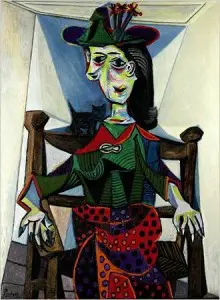
One of the world’s most expensive artworks, this painting depicts another of Picasso’s lovers. Dora Maar who sits regally on a brown, wooden chair, clothed in brilliant colors of red, green, and blue with a little, black cat sitting atop her right shoulder. The cat is said to represent Dora Maar’s allure and temperament which Picasso likened to an Afghan cat. In art, when a woman and a cat are depicted together, this is in reference to a woman’s feminine wiles and her sexual aggression.
Conclusion
Whether in love or in lust, in fear or in pain of loss, in anger or in disgust, Picasso has always remained consistent in producing thought-evoking, emotion-ridden masterpieces which to this day continue to speak his words… ‘Art is a lie that makes us realize the truth.’








Leave a Reply